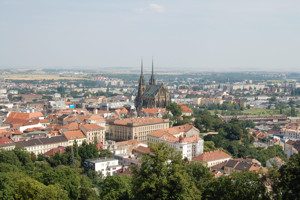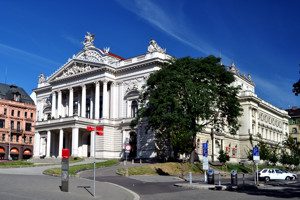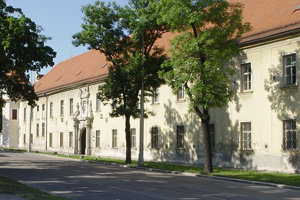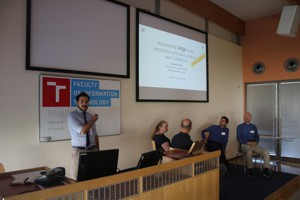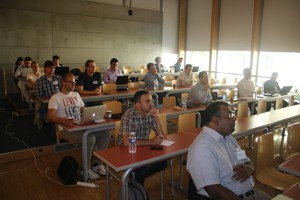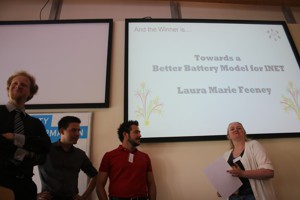OMNeT++ Community Summit 2016
Successor of the International Workshop on OMNeT++
Brno University of Technology – Czech Republic – September 15-16
INTRODUCTION
The third OMNeT++ Community Summit will be held at the Faculty of Information Technology of the Brno University of Technology (FIT-BUT) in the Czech Republic on Thursday and Friday, September 15-16, 2016.
OMNeT++ is a public-source, component-based, modular and open-architecture simulation environment with strong GUI support and an embeddable simulation kernel. It is designed to simulate discrete event systems, but the primary application area is the simulation of communication networks.
In continuation of the history of the International Workshop on OMNeT++ and two very successfull editions of its reincarnation, the OMNeT++ Community Summit, we continue on the path of holding a yearly, open meeting for all members of the OMNeT++ community with less costs and more interaction between the participants. The Community Summit provides a forum for tutorials, discussion sessions and presentations on recent developments and novel ideas in the area of network simulation and modeling, with a focus on the OMNeT++ simulation environment.
The second Summit in Zurich was a huge success with over 55 on-site participants, two keynotes, two tutorials, several panel discussions, posters, demonstrations, and around 14 presentations of ongoing and finalized research covering many aspects of OMNeT++-related research. The 2016 event continues to expand the idea of a community summit by explicitly addressing the interaction through tutorials and panels with additional discussion slots while keeping the extended 2-day time frame of the 2015 summit.

SUMMIT PROGRAM
The OMNeT++ Summit intends to be a lively event with a lot of discussions. A wide range of presentations, talks and demonstrations regarding specific sub-topics will be held. Additional panels and tutorials are planed at the moment. There will be enough time to discuss about the different parts of OMNeT++ and related simulation and modeling questions.
Proceedings
Thursday, 15. September 2016 |
All sessions will take place at Brno University - Faculty of Information Technology - Building C - Lecture Hall E105. Please follow the OMNeT++ Community Summit signs. |
|
| 08:30 - 09:00 | Registration | |
| 09:00 - 09:15 | Welcome Note
⇒ Presentation Slides [PDF] – Presentation [Video] |
|
| 09:15 - 11:00 | Session: INET and OMNeT++ Developments Part I Chair: Kyeong Soo (Joseph) Kim |
|
|
Felix Weinrank, Irene Rüngeler, Michael Tüxen and Erwin Rathgeb SCTP User Message Interleaving - Integration and Validation The Stream Control Transmission Protocol (SCTP) is a connection and message oriented transport protocol. It supports multiple uni-directional streams in each direction allowing user message sequence preservation within each stream. This minimizes the re-sequencing delay at the receiver side in case of message loss. The base protocol, although being optimized for small messages, supports arbitrary large user messages by using fragmentation and reassembly at the cost of adding delays at the sender side. To overcome this limitation, a protocol extension called User Message Interleaving is currently being specified by the Internet Engineering Task Force (IETF). This paper describes the new extension, its integration and validation in the context of the INET framework. ⇒ arXiv Page – Publication [PDF] – Presentation Slides [PDF] – Presentation [Video] |
||
|
Atheer Al-Rubaye, Ariel Aguirre and Jochen Seitz Enabling Soft Vertical Handover for MIPv6 in OMNeT++ Switching connectivity over multiple wireless interfaces of a mobile node is essential when performing handover between heterogeneous networks. In such a communication scenario, session continuity as experienced by the user can be enhanced if soft handover is enabled through the concept of make-before-break. However, some of the available networking protocols need to be modified to support this feature. This work gives an insight into the supplementary modules we implemented and the modification conducted in MIPv6 model of OMNeT++ to facilitate soft handover and data offloading for mobile nodes. ⇒ arXiv Page – Publication [PDF] – Presentation Slides [PDF] – Presentation [Video] |
||
|
Marco Tiloca, Alexandra Stagkopoulou and Gianluca Dini Performance and Security Evaluation of SDN Networks in OMNeT++/INET Software Defined Networking (SDN) has been recently introduced as a new communication paradigm in computer networks. By separating the control plane from the data plane and entrusting packet forwarding to straightforward switches, SDN makes it possible to deploy and run networks which are more flexible to manage and easier to configure. This paper describes a set of extensions for the INET framework, which allow researchers and network designers to simulate SDN architectures and evaluate their performance and security at design time. Together with performance evaluation and design optimization of SDN networks, our extensions enable the simulation of SDN-based anomaly detection and mitigation techniques, as well as the quantitative evaluation of cyber-physical attacks and their impact on the network and application. This work is an ongoing research activity, and we plan to propose it for an official contribution to the INET framework. ⇒ arXiv Page – Publication [PDF] – Presentation Slides [PDF] – Presentation [Video] |
||
|
Laura Marie Feeney Best Contribution of the 2016 OMNeT++ Community Summit Towards a Better Battery Model for INET Battery lifetime is often an important performance metric when simulating networks containing wireless devices. When evaluating system or protocol performance, there are cases where it is useful for the battery model to more accurately reflect the complex electrochemical processes involved in battery discharge. This paper describes an implementation of the KiBaM battery discharge model for INET. With regard to the INET implementation itself, the main technical issue is to extend the INET power model to more effectively handle both constant output voltage energy sources (mains power and simple battery models) and variable output voltage sources (complex battery models). A custom battery testbed allows us to measure the discharge behavior of Li-coin cells under controlled conditions. The testbed is capable of coarse-grain modeling of the current draw associated with an IEEE 802.15.4 radio transmitting a frame. This enables a preliminary comparison between the simulation model and real discharge behavior. ⇒ arXiv Page – Publication [PDF] – Presentation Slides [PDF] – Presentation [Video] |
||
| 11:00 - 11:30 | Coffee Break | |
| 11:30 - 12:15 | Panel: Simulation and Data Analysis Chair: Antonio Virdis |
|
|
Antonio Virdis, Carlo Vallati and Giovanni Nardini Automating Large-Scale Simulation and Data Analysis with OMNeT++: Lessons Learned and Future Perspectives Simulation is widely adopted in the study of modern computer networks. In this context, OMNeT++ provides a set of very effective tools that span from the definition of the network, to the automation of simulation execution and quick result representation. However, as network models become more and more complex to cope with the evolution of network systems, the amount of simulation factors, the number of simulated nodes and the size of results grow consequently, leading to simulations with larger scale. In this work, we perform a critical analysis of the tools provided by OMNeT++ in case of such large-scale simulations. We then propose a unified and flexible software architecture to support simulation automation. ⇒ arXiv Page – Publication [PDF] – Presentation Slides [PDF] – Presentation [Video] |
||
| 12:15 - 13:15 | Lunch Break (self-paid) | |
| 13:15 - 14:30 | Session: INET and OMNeT++ Developments Part II Chair: Michael Kirsche |
|
|
Syphax Iskounen, Thi Mai Trang Nguyen and Sebastien Monnet WiFi-Direct Simulation for INET in OMNeT++ Wi-Fi Direct is a popular wireless technology which is integrated in most of today’s smartphones and tablets. This technology allows a set of devices to dynamically negotiate and select a group owner which plays the role access point. This important feature is the strength of Wi-Fi Direct and makes it more and more widely used in telecommunications networks. In this paper, we present the implementation of Wi-Fi Direct in the INET framework of OMNeT++. We have implemented the main procedures of Wi-Fi Direct such as discovery, negotiation and group formation. The implementation has been validated by two test scenarios which show the conformity of the implementation to the protocol specification. ⇒ arXiv Page – Publication [PDF] – Presentation Slides [PDF] – Presentation [Video] |
||
|
Invited Speaker: András Varga Plans for OMNeT++ 5.1 This presentation covers the current development regarding the next OMNeT++ release. ⇒ Presentation Slides [PDF] – Presentation [Video] |
||
|
Invited Speaker: Rudolf Hornig SQLite as a Result File Format for OMNeT++ This presentation introduces a proof of concept implementation of output vector and output scalar recorders that write the data into an SQLite database. The OMNeT++ IDE has also been taught to recognize them. The perceived advantage is easier access to the data using SQL, while other languages like Python and R have SQLite support. ⇒ Presentation Slides [PDF] – Presentation [Video] |
||
| 14:30 - 15:15 | Tutorial: SimuLTE Chair: Antonio Virdis |
|
|
Giovanni Nardini, Antonio Virdis and Giovanni Stea Simulating Device-to-Device Communications in OMNeT++ with SimuLTE: Scenarios and Configurations SimuLTE is a tool that enables system-level simulations of LTE/LTE-Advanced networks within OMNeT++. It is designed such that it can be plugged within network elements as an additional Network Interface Card (NIC) to those already provided by the INET framework (e.g. Wi-Fi). Recently, device-to-device (D2D) technology has been widely studied by the research community, as a mechanism to allow direct communications between devices of a LTE cellular network. In this work, we present how SimuLTE can be employed to simulate both one-to-one and one-to-many D2D communications, so that the latter can be exploited as a new communication opportunity in several research fields, like vehicular networks, IoT and machine-to-machine (M2M) applications. ⇒ arXiv Page – Publication [PDF] – Presentation Slides [PDF] – Presentation [Video] |
||
| 15:15 - 15:45 | Coffee Break | |
| 15:45 - 17:15 | Session: OMNeT++ Extensions Chair: Vladimír Veselý |
|
|
Till Steinbach, Philipp Meyer, Stefan Buschmann and Franz Korf Extending OMNeT++ Towards a Platform for the Design of Future In-Vehicle Network Architectures In-vehicle communication technologies are evolving. While today’s cars are equipped with fieldbusses to interconnect the various electronic control units, next generation vehicles have timing and bandwidth requirements that exceed the capacities. In particular Advanced Driver Assistance Systems (ADAS) and automated driving using high bandwidth sensors such as cameras, LIDAR or radar will challenge the in-car network. Automotive Ethernet is the most promising candidate to solve the upcoming challenges. But to design and evaluate new protocols, concepts, and architectures suitable analysis tools are required. Especially in the interim period with architectures using automotive Ethernet and legacy fieldbusses together, careful planning and design is of vital importance. Simulation can provide a good understanding of the expectable network metrics in an early development phase. This paper contributes a workflow as well as the required toolchain to evaluate new real-time Ethernet communication architectures using event based simulation in OMNeT++. We introduce a domain specific language (DSL) – the Abstract Network Description Language (ANDL) – to describe and configure the simulation and present the required simulation models for real-time Ethernet and fieldbus technologies such as CAN and FlexRay. We further introduce new analysis tools for special in-vehicle network use-cases and the interaction of the simulation with third-party applications established in the automotive domain. ⇒ arXiv Page – Publication [PDF] – Presentation Slides [PDF] – Presentation [Video] |
||
|
Wolfgang Wallner Simulation of the IEEE 1588 Precision Time Protocol in OMNeT++ Real-time systems rely on a distributed global time base. As any physical clock device suffers from noise, it is necessary to provide some kind of clock synchronization to establish such a global time base. Different clock synchronization methods have been invented for individual application domains. The Precision Time Protocol (PTP), which is specified in IEEE 1588, is another interesting option. It targets local networks, where it is acceptable to assume small amounts of hardware support, and promises sub-microsecond precision. PTP provides many different implementation and configuration options, and thus the Design Space Exploration (DSE) is challenging. In this paper we discuss the implementation of realistic clock noise and its synchronization via PTP in OMNeT++. The components presented in this paper are intended to assist engineers with the configuration of PTP networks. ⇒ arXiv Page – Publication [PDF] – Presentation Slides [PDF] – Presentation [Video] |
||
|
Kyeong Soo Kim Stacked-VLAN-Based Modeling of Hybrid ISP Traffic Control Schemes and Service Plans Exploiting Excess Bandwidth in Shared Access Networks The current practice of shaping subscriber traffic using a token bucket filter by Internet service providers may result in a severe waste of network resources in shared access networks; except for a short period of time proportional to the size of a token bucket, it cannot allocate excess bandwidth among active subscribers even when there are only a few active subscribers. To better utilize the network resources in shared access networks, therefore, we recently proposed and analyzed the performance of access traffic control schemes, which can allocate excess bandwidth among active subscribers proportional to their token generation rates. Also, to exploit the excess bandwidth allocation enabled by the proposed traffic control schemes, we have been studying flexible yet practical service plans under a hybrid traffic control architecture, which are attractive to both an Internet service provider and its subscribers in terms of revenue and quality of service. In this paper we report the current status of our modeling of the hybrid traffic control schemes and service plans with OMNeT++/INET-HNRL based on IEEE standard 802.1Q stacked VLANs. ⇒ arXiv Page – Publication [PDF] – Presentation Slides [PDF] – Presentation [Video] |
||
|
Invited Speakers: Pavlos Maniotis, Nikos Terzenidis and Nikos Pleros The OptoHPC-sim simulator: Bringing OptoBoards to HPC-scale environments The increased communication bandwidth demands of HPC-systems calling at the same time for reduced latency and increased power efficiency have designated optical interconnects as the key technology in order to achieve the target of exascale performance. In this realm, technology advances have to be accompanied by corresponding simulation tools that support end-to-end system modeling in order to evaluate the performance benefits offered by optical components at system-environment. We present here the OptoHPC-Sim, which supports the utilization of optical interconnect and electro-optical routing technologies at system-scale offering complete end-to-end simulation of HPC-systems and allowing for reliable comparison with existing HPC platforms. OptoHPC-sim has been developed using the OMNeT++ platform and is designed to offer the optimum balance between the model detail and the simulation execution time. We describe the design of the simulation engine and demonstrate the capabilities of OptoHPC-sim by comparing an HPC system employing state-of-the-art optoelectronic routers and optical interconnects with the Cray XK7 system platform. ⇒ Presentation Slides [PDF] – Presentation [Video] |
||
| 17:15 - 17:30 | Coffee Break | |
| 17:30 - 18:30 | Invited: Animation in OMNeT++ 5 Chair: Michael Kirsche |
|
|
Invited Speakers: Attila Török, Levente Mészáros and András Varga Enhancing Visualization and Animation in Simulation Models On top of the Canvas API, the OMNeT++ development team has worked out a solution that allows one to implement high-quality custom animations, including real-time, scaled real-time, variable scale animations and more. This presentation introduces the new animation and visualization possibilities for simulation models. ⇒ Presentation Slides [PDF] – Presentation [Video] |
||
|
Invited Speaker: Levente Mészáros Visualization in the INET Framework This short talk introduces methods and approaches of visualization specifically in the INET framework. ⇒ Presentation Slides [PDF] – Presentation [Video] |
||
| 18:45 | Meeting for trip to the evening dinner location. Detailed directions will be provided on-site. | |
| 20:00 - open end |
Discussion and Dinner (self-paid) | |
| Dinner Venue: PIVOVARSKÁ STAROBRNO Address: Mendlovo náměstí 20, Brno Located next to the Starobrno brewery, this restaurant has a good selection of food and draft beer. English menu available – Location on Google Maps |
||
Friday, 16. September 2016 |
All sessions will take place at Brno University - Faculty of Information Technology - Building C - Lecture Hall E105. Please follow the OMNeT++ Community Summit signs. |
|
| 09:00 - 10:15 | Session: Routing and Mobility Chair: Laura Marie Feeney |
|
|
Benjamin Sliwa, Christoph Ide and Christian Wietfeld An OMNeT++ based Framework for Mobility-aware Routing in Mobile Robotic Networks In this paper, we propose a cross-layer extension for the INETMANET framework of OMNeT++, which utilizes mobility control knowledge to enhance the forwarding of routing messages. The well-known mobility meta-model from Reynolds is used to provide a realistic representation of the mobility behavior of autonomous agents with respect to the various influences those agents have to face in real-world applications. Knowledge about the current mobility properties and its predicted development is used by mobility-aware routing mechanisms in order to optimize routing decisions and avoid path losses at runtime. In a proof of concept evaluation we show that our proposed methods can achieve significant improvements to the robustness of communication paths. ⇒ arXiv Page – Publication [PDF] – Presentation Slides [PDF] – Presentation [Video] |
||
|
Asanga Udugama, Behruz Khalilov, Anas Bin Muslim, Anna Förster and Koojana Kuladinithi Implementation of the SWIM Mobility Model in OMNeT++ The Internet of Things (IoT) is expected to grow into billions of devices in the near future. Evaluating mechanisms such as networking architectures for communications in the IoT require the use of simulators due to the scale of the size of networks. Mobility is one of the key aspects that need to be evaluated when considering the different scenarios of the IoT. Small Worlds in Motion (SWIM) is a mobility model that mathematically characterises the movement patterns of humans. The work presented in this paper details the development and verification of the SWIM mobility model in the OMNeT++ simulator. ⇒ arXiv Page – Publication [PDF] – Presentation Slides [PDF] – Presentation [Video] |
||
|
Vladimír Veselý, Vít Rek and Ondřej Ryšavý Babel Routing Protocol for OMNeT++: More than just a new Simulation Module for INET framework Routing and switching capabilities of computer networks seem as the closed environment containing a limited set of deployed protocols, which nobody dares to change. The majority of wired network designs are stuck with OSPF (guaranteeing dynamic routing exchange on network layer) and RSTP (securing loop-free data-link layer topology). Recently, more use-case specific routing protocols, such as Babel, have appeared. These technologies claim to have better characteristic than current industry standards. Babel is a fresh contribution to the family of distance-vector routing protocols, which is gaining its momentum for small double-stack (IPv6 and IPv4) networks. This paper briefly describes Babel behavior and provides details on its implementation in OMNeT++ discrete event simulator. ⇒ arXiv Page – Publication [PDF] – Presentation Slides [PDF] – Presentation [Video] |
||
| 10:15 - 10:45 | Coffee Break | |
| 10:45 - 11:15 | Invited: Framework and Research Project Introduction Chair: Michael Kirsche |
|
|
Invited Speaker: Vladimír Veselý Introducing OMNeT++-based Research Frameworks: ANSAINET INET is well-known OMNeT++ framework allowing simulation and modeling of traditional TCP/IP-based networks. ANSAINET extends the functionality of original INET framework with various technologies focused on wired networks. ANSAINET contributed to INET with multicast routing, PIM protocol, RIP and others in the past. During the last year, we have successfully migrated our framework to INET 3.3 (compatible with OMNeT++ 5.0). Moreover, we developed a lot of new simulation modules (e.g., EIGRP, Babel, IS-IS, TRILL, LISP, CDP, LLDP, HSRP, VRRP, GLBP) and we would like to tell the community about them. For more information, take a look at the project's Github repository. ⇒ Presentation Slides [PDF] – Presentation [Video] |
||
|
Invited Speaker: Marcel Marek Introducing OMNeT++-based Research Frameworks: RINASim Recursive InterNetwork Architecture (RINA) is clean-slate approach trying to address issues of nowadays Internet. Issues like routing scalability of the default-free zone, cumbersome multihoming and mobility, problematic traffic engineering and QoS support, which are caused by design problems of traditional TCP/IP stack. RINASim is the first and only full-fledged simulator of native RINA networks that is being used as educational and research tool in the frame of multiple projects. For more information, take a look at the project's Github repository. ⇒ Presentation Slides [PDF] – Presentation [Video] |
||
| 11:15 - 12:20 | Invited: Future Directions for INET Chair: Antonio Virdis |
|
|
Invited Speaker: Rudolf Hornig An Update on the INET 3.x Developments Future directions of the INET 3.x development were presented at the last OMNeT++ Summit 2015 in Zurich. This presentation introduces the current status quo and discusses changes and possibilities for INET. ⇒ Presentation Slides [PDF] – Presentation [Video] |
||
|
Invited Speaker: Levente Mészáros An Update on the new INET IEEE 802.11 MAC Model This presentation follows the development of the newly IEEE 802.11 MAC Model, which was first introduced at the OMNeT++ Summit 2015. The introduced implementation draft has grown into a full-blown implementation with support for advanced features like block ACK and very strong standards compliance -- while the structure of the model has changed significantly. The presentation introduces the current state and the features and specifics of the new IEEE 802.11 MAC model. ⇒ Presentation Slides [PDF] – Presentation [Video] |
||
| 12:20 - 12:30 | Summit Closure Note + "Best Contribution Award"
Best Contribution 2016: Laura Marie Feeney - Towards a Better Battery Model for INET ⇒ Presentation Slides [PDF] – Presentation [Video] |
|
IMPRESSIONS
With around 30 on-site participants, two days of high-class presentations, tutorials and panel discussions, the third OMNeT++ Community Summit served as yet another excellent community get-together. We would like to express our gratitude to all people involved in the organization of the event and to all presenters and attendees.
Below you find impressions from the third summit.
CALL for PARTICIPATION
The summit brings together developers and researchers to discuss applications and ideas on the important topics of integrating simulation models, coupling different simulation tools and providing more accurate and more efficient modeling approaches.
We invite the researchers and users alike to submit one or more of the following contribution types:
- Abstracts (max. 4 pages) targeting ongoing and/or finalized research questions, introducing novel simulation techniques or new simulation models, and addressing questions of accurate and efficient modeling for simulation.
- Proposals for tutorials or demonstrations (max. 4 pages) on existing or new simulation frameworks, modeling techniques, OMNeT++ functionalities, and case studies.
Submissions to the summit should be of interest to the OMNeT++ community. We welcome case-studies that employ OMNeT++ in the evaluation of new systems as well as contributions addressing general questions of simulation using OMNeT++. For model-centric submissions we ask the author(s) to publicize source code at the time of submission.
All submissions will be checked by the technical program committee and the organizers. Individual contributions will be invited to be presented as oral presentations, demos, tutorials or panels, depending on the submission type and their expected interest for the OMNeT++ community. We will provide poster presentation slots for all interested participants to present their research work.
Proposals for coding sessions and discussion panels as well as other interactive community activities can be announced individually to the organizers before May 20th, 2016. Please contact the summit organizers via email if you want to organize your own interactive session during the summit.
Topics of interest include, but are not limited to:
- Design, evaluation, and validation of simulation models
- Comparison with other simulation / emulation tools
- Parallel simulation and simulation control
- Integration of hardware-specific code
- Simulative approaches to performance evaluation
- Cross-layer protocol design methodologies
- Simulation credibility and validation
- Use of discrete event simulation in other domains
- Integration with other simulation tools
- Result interpretation and analysis
- Modeling techniques, incl. stochastic and hybrid modeling
- Simulation in the loop
- Industrial applications and use cases
- Experiences on contributions to international standards
(e.g., IEEE and IETF) and / or patents
SUMMIT VENUE
The 3rd OMNeT++ Community Summit will take place at the Faculty of Information Technology - Brno University of Technology:
Božetěchova 1/2, 612 00 Brno, Czech Republic
On-Site Location:
Building C - Lecture Hall E105
Google Maps Link for the Building | Link to the floor map (first floor - E105)
Accommodation Information
Hotels near the event site:
Hotel Continental ****
Kounicova 680/6
602 00 Brno
Design Hotel Noem Arch ****
Cimburkova 9
612 00 Brno-Královo Pole
Hotel Continental is located right in the heart of the city center.
The university is easily accessible by tram within 15 minutes.
The Restaurant and Design Hotel Noem Arch is located close to the Kralovo Pole shopping mall. The hotel's restaurant is known for its exceptional food. Although not far from the university, you need to change the bus to get to the summit. This is the ideal place if you plan to go by car as it offers free parking and a convenient connection to the university.
Hotel Nove Semilasso ***
Palackého tr. 3048/124
612 00 Brno
VV Hotel ***
Mlýnská 8a
602 00 Brno
Hotel Nove Semilasso is a small apartment rental, located just next to the university campus (less than 3 minutes of walking). It offers good quality for a reasonable price.
VV Hotel is located in Brno's centre, just 200 m from the Vankovka shopping centre and the city's main railway station. It provides parking places and a very good quality/price relation.
For the full list of hotels, please check for instance www.booking.com and search for Brno. If you want to stay closer to the university, find hotels in the "Kralovo Pole" district. Brno has an efficient public transport service. Hotels in the city center are thus easily accessible from all important locations (bus station, railway station) as well as from the university campus.
Brno City Information
With around 400.000 inhabitants and 800.000 people living in its greater the metropolitan area, Brno is the second largest city in the Czech Republic by population and area. It is the largest Moravian city and the historical capital city of the Margraviate of Moravia.
Brno is a major administrative centre and the seat of the judicial authority of the Czech Republic.
The city is a major tourist destination with its large exhibition and trade fair centre, the Masaryk Racing Circuit, the Spilberk castle and fortress, and the Cathedral of Saints Peter and Pauland.
Major tourist attractions:
If you would like to spend some additional time in Brno, you could visit the following sights:
- Freedom Square (Náměstí Svobody)
- Špilberk Castle (Hrad Špilberk)
- Petrov Cathedral and Church of St. James
- Denis gardens (Denisovy sady) and Lužánky park (Park lužánky)
- Villa Tugendhat
- Brno Racing Circuit
- Various Museums and Galeries
- Various local microbreweries
- ... and many more ...
Travel Information
If you plan to arrive by plane:
- via Prague Václav Havel Airport (PRG):
Buses to Brno are operated by Student Agency. You must change the bus at Florenc station in Prague. - via Vienna International Airport (VIE):
Located near the town of Schwechat in Austria, the airport is the home base of the flag-carrier Austrian and the budget airline Fly Niki. Student Agency offers multiple direct daily coaches. - via Brno-Turany Airport (BRQ):
Brno airport is highly convenient if flights are available. It boasts an extremely impressive structure. Those interested in modern architecture may want to visit it even if they are not lucky enough to fly into the airport. - via Bratislava Airport (BTS):
The airport is the largest in the Slovak Republic and the home base of Danube Wings, though the budget airline Ryanair flies the vast majority of seat capacity. Additonal carriers are Aeroflot, CSA, Sun d'Or, and LOT.
If you plan to arrive by train:
- Brno is an important stop on the Prague-Vienna and Prague-Bratislava-Budapest railway line; all IC and EC trains stop here.
- For some trains originating in Prague, it is a terminal stop.
If you plan to arrive by bus:
- There are coach services from various European destinations including Prague where frequent buses run touting assorted amenities and stops (such as Prague Airport).
- Student Agency has its main hub in Brno and buses travel across Europe.
- Bohemian Lines is a Brno based company. Buses roll off to Scandinavia every couple of days headed for Copenhagen, Stockholm, Oslo and a slew of more exotic smaller towns.
- Tourbus, a.s. is also based in Brno and serves many destinations and is particularly cheap to some international destinations.
- Eurolines CZ/Touring Bohemia, s. r. o., offers international and domestic routes.
ORGANIZERS
Founding Chair
- András Varga (Simulcraft Inc.)
Community Summit Organizers
- Anna Förster (University of Bremen, Germany)
- Vladimír Veselý (Brno University of Technology, Czech Republic)
Technical Program Organizers
- Antonio Virdis (University of Pisa, Italy)
- Michael Kirsche (BTU Cottbus–Senftenberg, Germany)
Publicity Organizer
- Kyeong Soo (Joseph) Kim (Xi'an Jiaotong–Liverpool University, China)
- Laura Marie Feeney (Uppsala University, Sweden)
Technical Program Committee
- Michael Frey (HU Berlin, Germany)
- Yutaka Matsubara (Nagoya University, Japan)
- Cyriel Minkenberg (Rockley Photonics Inc., USA)
- Georg Panholzer (Salzburg Research, Austria)
- Alfonso Ariza Quintana (University of Malaga, Spain)
- Gabrielle Romaniello (Schneider Electric, France)
- Christoph Sommer (University of Paderborn, Germany)
- Dora Spenza (Sapienza University of Rome, Italy)
- Mirko Stoffers (RWTH Aachen University, Germany)
- Carlo Vallati (University of Pisa, Italy)
Sponsors
The OMNeT++ Community Summit 2016 is sponsored and free to attend by everyone. No registration fees will be applied.
